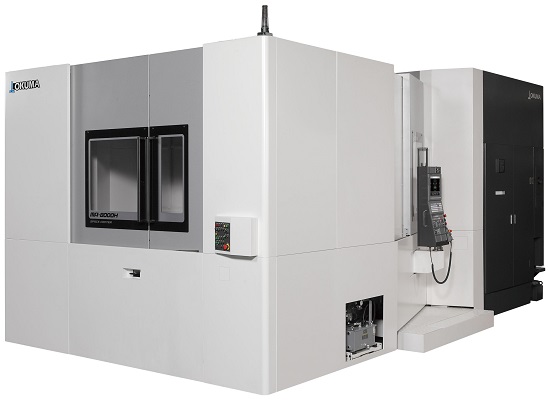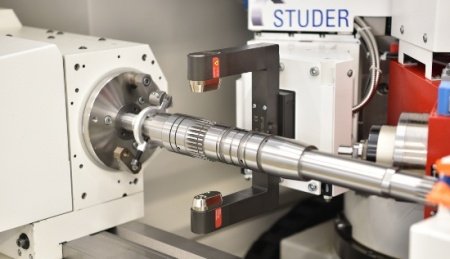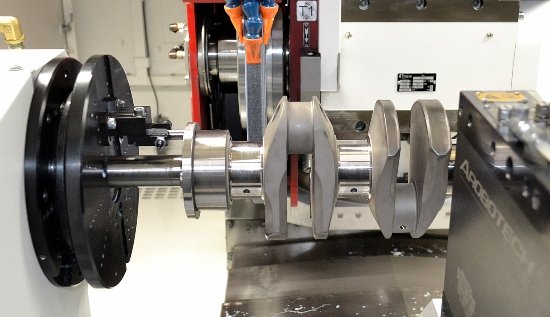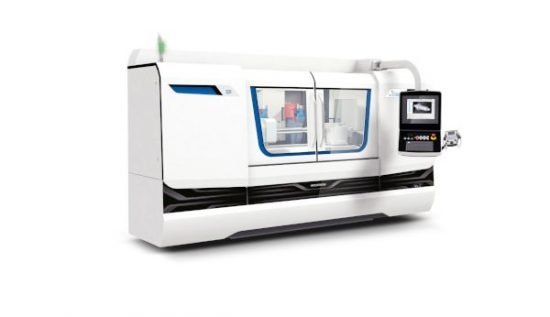Benefit From Tried And-Tested Grinding Technology From STUDER
Contract manufacturers in particular must be able to trust in the technologies, machines, and processes they use to produce one-off and small-batch components with extreme precision and process reliability. That’s why Ingold Tools AG, a well-known precision manufacturer, relies on CNC cylindrical grinding machines from STUDER.
Latest Product Launches From Okuma To Studer
NORDAC FLEX Frequency Inverters From NORD DRIVESYSTEMS
The large power range, up to 22 kW, is characteristic for the frequency inverter. In addition, the NORDAC FLEX SK 205E is compact and enables high precision in synchronous and positioning applications via the integrated POSICON control Another advantage is the precise and rapid current vector control: It ensures constant speeds in case of fluctuating loads. The NORDAC FLEX SK 205E also offers maximum flexibility and due to its high energy efficiency enables energy savings, especially during partial load operation. This even applies to applications that technically do not require an inverter.

Okuma Corporation Launches New Horizontal Machining Center
Okuma Corporation has developed the new MA-8000H Horizontal Machining Center with a pallet size of 800 x 800 mm. Equipped with extensive power-saving functions and eco-friendly technologies that operate autonomously without human intervention, this new product strongly supports user efforts to decarbonise.
Okuma would like to introduce three features of the MA-8000H:
- Autonomously achieves energy savings without human intervention.
- Sharply boosts labor productivity by strengthening automation responsiveness and reliability to support long periods of stable operation.
- Further improves production capacity to process large components with enhanced basic capabilities.
Orders will be accepted from January 2022.
Red Lion Launches Next Generation Graphical Panel Meter PM-50
Red Lion has introduced the next generation of panel meters PM-50. This graphical panel meter, PM-50, expands Red Lion’s existing award-winning panel meter portfolio. The PM-50 is available as a 3.5-inch or 4.3-inch graphical touchscreen display.
Using simple “swipe” technology, users can easily switch between relevant screens and receive comprehensive operational data for monitoring equipment and production.
Visual alerts notify the user that immediate action is necessary, either on the unit itself or via the PM-50 app, available on Google Play or Apple Store.

Sandvik Coromant Introduces A New Form Of Chip Control
Sandvik Coromant has unveiled a new machining method that enables controlled chip breaking in thread turning applications. Launched within the existing CoroPlus® Tool Path software, OptiThreading™ is a new software module that will help manufacturers overcome one of the most significant issues within thread turning — the risk of chip jams and their associated downtime.Successful chip control is the key for good component quality when thread turning. OptiThreading™ has been designed with these challenges in mind. The module is available as part of a subscription to the CoroPlus® Tool Path, and is developed specifically for CoroThread® 266 tools and inserts.
Schaeffler’s Preload Measurement System, PREMESY
With the growth and development of renewable energy unfolding in the Asia-Pacific region, Schaeffler’s PREMESY Preload Measurement System is the first and only system on the market that monitors the bearing preload during mounting and operation of bearings in a wind turbine system. It provides the basis for predictive maintenance and ensures the continued reliable operation of wind systems and technologies by maximizing the bearing service life, lowering maintenance costs, and helping manufacturers avoid turbine failures.

With renewable energies looking to make a significant contribution to the overall energy mix, PREMESY is part of Schaeffler’s strategic investment in supporting the increased generation of energy from renewable sources.
Siemens’ New Simcenter NVH Prediction software Application
A new Simcenter™ software application that can bring the benefits of a comprehensive digital twin approach to accurately and easily predict the interior and exterior Noise, Vibration and Harshness (NVH) performance of a vehicle before a physical prototype is available for any type of vehicle: hybrid, fully electric or internal combustion engine (ICE). This new Simcenter™ application helps engineers front load full vehicle NVH analysis and detect potential component NVH performance issues earlier by using measured and simulated component models to build a virtual prototype assembly. Simcenter is part of Xcelerator, Siemens’ integrated portfolio of software, services and application development platform.

SLM Solutions’ Cooler And Faster Method For Manufacturing Plastic Injection Moulds
Omni Mold was approached by their customer to address the issue of inefficient cooling in one of the mould core insert. By investing in a SLM280 2.0, Omni Mold was able to completely reimagine the cooling channel within its mold inserts through laser-fast additive manufacturing. AM enables the manufacture of complex parts, in this case, replacing the spiral shape with a conformal cooling channel that targets the hotspot areas and improves cooling efficiency within the injection mold. This allows for uniform cooling across the entire product, thereby improving overall part quality, minimising distortion, and shortening the cycle time during production.
STUDER roboLoad, A New Type Of Loading System
Loading systems for CNC radius internal cylindrical grinding machines – that was not so easy until now. The special characteristics of these machines, such as the height of the workhead and the associated geometric restrictions, made the development of a handling solution a major challenge. STUDER has now developed a system that not only meets the geometrical requirements but also has a comparatively small footprint and an unbeatable price-performance ratio. For the user, the STUDER roboLoad can be operated without any programming knowledge; it enables great flexibility in production and a high degree of operating comfort.

WANT MORE INSIDER NEWS? SUBSCRIBE TO OUR DIGITAL MAGAZINE NOW!
Grind On A New Level With Studer WireDress
According to Fritz Studer AG, it has been possible to increase grinding power in the grinding process by 30% and reduce grinding wheel wear by 70% in comparison with ceramic and resin bonds.
Laser Process Measuring Technology for Precision Machining
Integrating laser measuring technology expands the possible applications of process measuring technology in grinding machines, supporting the user in his efforts to increase efficiency in precision machining. Article by STUDER.
Finishing processes on grinding machines often demand exacting tolerances in relation to dimension, form and position accuracies, as well as highly accurate surface qualities. Often, companies have empirical values available to fulfil these requirements.
However, with small lot sizes in particular, process evaluation on the machine is desirable, as intermediate measurement on external measuring machines and the resulting corrections prolong the processing time for part machining. These control measures would significantly increase process reliability and productivity. Solutions that can be flexibly used for a wide variety of workpieces are ideal and preferable.
Measuring Technology in Grinding Processes
Production engineers have diverse measuring functions available for process evaluation, which are based on different principles of production measuring technology. The measurement of process forces such as grinding forces (Ft, Fn) or comparative grinding spindle currents, for example, provide an index for achieving the service life of tools or, equally important, they enable the determination of fluctuating allowances, which can influence process stability and compliance with required tolerances.
In addition, tool costs can be reduced, as excessive dressing is prevented. Familiar acoustic touch sensors assist so-called contact detection in the grinding process to reduce grinding time, or monitor the true-to-profile dressing process with its envelope curve functions. Tactile measuring systems such as measurement and control systems for diameters or workpiece lengths, pneumatic systems or microsensors for longitudinal expansions of spindle systems also support increased process reliability.
Other measuring functions can also be described here, such as the use of camera or laser systems for process monitoring. Laser measuring technology in particular opens up interesting fields of application.
Integrating Laser Measuring Technology into Grinding Machines
STUDER can draw on more than 10 years of experience in the use of machine-integrated laser measuring technology, which have been evaluated for trials in the measurement of grinding wheels or workpieces. Such fundamental studies have a tradition at STUDER, to ensure the company is prepared for future trends in production technology. This knowledge and experience has been used to respond to the current requirements. The systems used in other industries for tool monitoring have been further developed by STUDER, on the basis of the latest laser measuring technology, only recently available, for measuring workpieces on grinding machines.
To continue reading this article, head on over to our Ebook!
For other exclusive articles, visit www.equipment-news.com.
WANT MORE INSIDER NEWS? SUBSCRIBE TO OUR DIGITAL MAGAZINE NOW!
FOLLOW US ON: LinkedIn, Facebook, Twitter
When Grinding Receives An Unprecedented Dimension
Dressing technology enables completely new possibilities in grinding with metal bonded CBN and diamond wheels. Article by Fritz Studer AG.
Alfred Mair, Head of Grinding Technology at Fischer AG, faces a challenge. The company, a manufacturer of high-precision spindles, has reached its limits in the grinding of exotic materials such as titanium and hard-to-machine hard materials under the increasing quality demands from the customers. That, plus their need to increase productivity, can’t be solved by conventional grinding machines.
Then came Fritz Studer AG’s S41 CNC universal cylindrical grinding machine. Specifically designed for large workpieces, it has a length between centres of 1000/1600 mm and a centre height of 225/275 mm. It processes workpieces with high precision up to a maximum weight of 250 kg, just as effectively as small and medium-sized workpieces. But the key for Fischer is the fully integrated WireDress dressing system.
“We had high hopes that we could use metal-bonded grinding wheels for a measurable and reproducible highest quality, have a higher productivity, more universal machining options as well as reduced tool costs,” Mair explains his expectations.
Expectations Exceeded
STUDER configured the S41 with WireDress based on additional requirements from Fischer. Thus, the machine received a special high-speed external grinding motor spindle, an innovative proprietary product of Fischer, in which the axial growth is particularly small.
In addition, the spindle is tapered at the rear end, avoiding possible collision situations. This is a specific benefit for face/shoulder grinding with the spindle at an angle. The S41 is supplemented with a fully automatic workpiece magazine and handling system, which ensures fully automatic series production of the high-quality precision components in a stand-alone operation.
“I am blown away,” says Mair. “Three to five times faster than with conventional technology, with absolute reproducibility, ground in a tolerance range of less than 1μm! I have never seen anything like that! I am extremely impressed.”
The Secret Behind
But how does this dressing technology work? Michael Klotz, project manager for development at Studer, explains, “It is a well-known fact that metal-bonded grinding wheels are much more durable and dimensionally stable when machining difficult-to-machine materials and ultimately enable higher productivity. The problem with this is that metal bonds can only be dressed to a very limited extent using conventional methods in the grinding machine. In addition to this, there is a high dressing tool wear associated with a low cutting ability. This is neither an operator-friendly, nor a high quality and process consistent dressing method.”
To continue reading this article, head on over to our Ebook!
For other exclusive articles, visit www.equipment-news.com.
Check these articles out:
Mühlhoff Starts Production On Large Presses After Fire With Help From Schuler Service
Studer: A New Lease of Life for Your Machine
ANCA Launches CIM3D V9 With Time-Saving And User-Friendly Enhancements
The Importance of Automation for Networked Manufacturing and Digitisation
ANDRITZ Strengthens Technology Leadership With Train Wheel Production Line
Growth Opportunities In Singapore’s Precision Engineering Sector
Global Grinding Machine Market To Hit US$5.06B
WANT MORE INSIDER NEWS? SUBSCRIBE TO OUR DIGITAL MAGAZINE NOW!
FOLLOW US ON: LinkedIn, Facebook, Twitter
Studer: A New Lease of Life for Your Machine
Any grinding machine with 45,000 operating hours on its log will wear. The question is, will you buy a new one, or refurbish the old one? Find out in this article from STUDER.

Before
LMT Kieninger specialises in highly demanding machining tasks and manufactures special tools for die and mould making. One of its equipment is the Studer S40 Grinding Machine, which has been in use for 14 years now.
“The S40 was the Rolls Royce of grinding machines. But the machine still wears over time and after intensive use,” admits Heiko Braun, Group Manager of Cylindrical/Surface Grinding and Assembly at LMT Kieninger.
It was clear to LMT Kieninger that they should send the cylindrical grinding machine to the STUDER factory in Switzerland for an overhaul. STUDER provided them with a loan machine for around three months and took care of everything from—from collection through to customs formalities.
“We were very satisfied with the loan machine. Apart from a few little things, we were able to continue grinding as usual,” sums up Braun.
What’s special about machine overhauls at STUDER is that it is the only company to refurbish the machines’ guideways to the original specifications. After the assemblies have been reinstalled, the machine geometry is equivalent to that of a new machine.
“This point in particular really convinced us. We notice the difference. Since the overhaul, we have been grinding with the precision of a new machine. I can only recommend a machine overhaul. Everything went without a hitch, the investment has paid off and a 1,600 mm machine is worth its weight in gold for us,” says Braun.
Rebuild—New from Old

After
A rebuild, or a machine overhaul, makes sense—and not just economically. The operator gets his familiar machine back and continues where he stopped before the overhaul. The difference is that his old machine is like new.
In STUDER‘s factory, specialists disassemble the machine into all its individual parts. The guideways are completely refurbished, the assemblies overhauled, the wear parts in the electric cabinet replaced, and the hydraulic and lubricating system as well as all valves replaced. If old spare parts can no longer be obtained, STUDER provides an alternative solution. The casing and components are sand-blasted and then given a fresh coat of paint.
After assembly, the geometry is like that of a new machine. Commissioning is carried out by STUDER Customer Care, including a functional and geometry inspection, which are all CE-compliant.
“Over 20 people work on machine overhauls at STUDER. This shows the value of rebuild and retrofit at the company. The customers are always enthusiastic about the transformation and are delighted to put an as-new machine into operation at an excellent price-performance ratio,” says Marcos Cotarelo, Divisional Head and Customer Care Consultant at STUDER.
Expanding the Component Range
If the customer wishes to expand his component range at the same time as the overhaul, he can do it with a retrofit. During the machine overhaul, the machine can be modified or retrofitted to the customer’s requirements. This opens up new production possibilities on the same machine. Ingold Tools AG has taken advantage of this STUDER service.
Ingold Tools has been producing high-precision and complex parts for spindle, compressor, hydraulic, and general machine manufacturing since 1946. Its machinery include a variety of CNC and conventional machines, including robotics and automation solutions for turning, milling/drilling, honing, lapping, barrel finishing, sand-blasting, laser marking, as well as surface and cylindrical grinding.
The cylindrical grinding shop already has several conventional and CNC STUDER machines. A further machine is currently being overhauled in the STUDER production halls—an 18-year old S21 with two external spindles and continuous fine adjustment of the turret wheelhead (B-axis fine), which the two managing directors Christoph Jenzer and Edgar Stich recently took on as a second-hand machine.
The S21 will not only be updated in line with the latest developments, but will also be retrofitted to suit the needs of Ingold Tools. In particular, the cylindrical grinding machine will have an additional internal grinding spindle for internal cylindrical grinding and the relevant fixture for swiveling the tailstock into the park position. The S21 will also have a new spindle cooling system with its own circuit, as well as a hydraulically swiveling dressing unit. For all grinding machines to have the same mounting, the universal tool headstock will also be upgraded from MK4 to MK5.
“This deal is perfect for us. Thanks to the retrofit, we get the second-hand machine with 50 percent new hardware,” says Jenzer.
Trusted Quality
The S21 is the second factory-rebuilt STUDER machine at Ingold Tools. In 2016, the company took on a second-hand S31 machine, which STUDER overhauled.
“We grind to a bearing tolerance and diameter of 1 mm. STUDER guarantees this accuracy after the overhaul. Either way, an overhauled STUDER will run just as long as a new machine,” says Stich.
Jenzer and Stich see a further advantage of the machine overhaul in the operation—their employees don’t need to get used to a new machine with a new control system.
Ingold Tools has relied on STUDER since its establishment. The first external cylindrical grinding machine was a Type 01 from 1955. This was still in use when Jenzer joined the company 13 years ago.
“We like working with STUDER. The service personnel are quick to respond, and our customer care consultant supports us wherever he can. It’s not without reason that we have so many STUDER machines,” he says.
A new machine? Jenzer and Stich both agree that they wouldn’t rule it out, as a new machine always offers advantages that an old one doesn’t have, such as faster travel in all axes, simpler set-up of the machine, and easy programming with less technical knowledge. But the employees are looking forward to the overhauled S21, which will soon be on its way to Inkwil in Bern.
Check these articles out:
GE Aviation Forms Engine Overhaul Joint Venture with SIAEC, Announces New Plant
Airbus Chooses China Airlines As MRO Supplier
Frost & Sullivan Names Top Innovators In The Global Commercial Aircraft MRO Market
Star SU Samputensili SG 160 Sky Grind Dry-Grinding Machine
Reducing Energy & Lubricants In The Automotive Industry
WANT MORE INSIDER NEWS? SUBSCRIBE TO OUR DIGITAL MAGAZINE NOW!
FOLLOW US ON: LinkedIn, Facebook, Twitter
Arrow Precision Relies on STUDER Grinding Tech
Increasing global demand for Arrow Precision’s crankshafts recently prompted a search for a premium quality, highly-productive grinding machine that had the capabilities to grind crankshaft main bearing journals and pins to the company’s challenging dimensional and surface finish standards. Here’s what drove the company to select Studer.

StuderWIN software helps the operator achieve complex grinding tasks.
Established in 1974 by David Arnold, and currently under the direction of David’s son Ian, Arrow Precision continues to abide by the founder’s guiding principles of quality, innovation and service.
The Hinckley, Leicestershire-based business’ highly skilled workforce have access to a wide range of premium quality machine tools enabling the company’s high-quality connecting rods and crankshafts to deliver ultimate levels of performance.
Having gained a global reputation for the components it produces, Arrow Precision now supplies three main automotive sectors. The company manufactures OE connecting rods and crankshafts for use in performance production road cars for prestigious customers throughout the world.
In addition, a custom service is provided offering unique forgings, custom designs and the one-off manufacture of complete sets of rods for classic and vintage cars. Last but not least, the motorsport industry’s insistence on dealing with vendors with high-levels of technical expertise, flexible manufacturing process, and fast delivery times, means that Arrow Precision is now a major supplier to this most challenging of automotive sectors.
Increasing global demand for Arrow Precision’s crankshafts recently prompted a search for a premium quality, highly-productive grinding machine that had the capabilities to grind crankshaft main bearing journals and pins to the company’s challenging dimensional and surface finish standards. Having assessed several machines from leading manufacturers against a demanding list of criteria, a practical demonstration of a Studer S41 CNC universal grinding machine convinced Arnold that the advanced Studer offering was the ideal answer to the company’s requirements.
The S41
With distances between centres of 1,000/1,600 mm, centre heights of 225mm/275mm and the capability of machining workpieces with a maximum weight of 250kg, the Studer S41 CNC universal cylindrical grinding machine was designed to accommodate medium to large workpieces. While the majority of daily grinding tasks can be efficiently performed on the machine, the S41 can also be configured for single-purpose use.
Studer’s S41 boasts a wide range of advanced technical features, such as the StuderGuide guideway system, high-precision axis drives with linear motors, and extremely fast direct drive of the B-axis, ensuring great flexibility, high precision and short auxiliary times. Given the diverse nature of the S41’s users, potential customers are able to choose from a large number of wheelhead variants. With up to four grinding wheels, the S41 fulfils virtually every requirement for complete machining.
The S41 is based on a robust Granitan S103 mineral casting machine bed. Developed and produced in the company’s own plant using the most modern industrial techniques, The advantageous material structure, has proven its value over many years. The excellent dampening characteristics of the S41’s machine base ensure outstanding surface quality of all ground workpieces. The use of Granitan S103 extends the service life of the grinding wheels, leading to reduced downtimes. In addition, temporary temperature fluctuations are compensated by the favourable thermal behaviour of this remarkable material.
TOP METALCUTTING ARTICLES FOR THE MONTH
Micro Electrical Discharge Technologies
The Studer S41’s versatile universal workhead enables both live spindle grinding and grinding between centres. The machine can also be fitted with a specially designed chuck workhead for chuck applications. The workhead is mounted on low-maintenance roller-bearings that have an excellent roundness accuracy of below 0.0004mm (optional, 0.0002mm). Fine adjustment allows for cylindricity corrections in the 1µm range during live spindle operations. As with the machine’s tailstock, its workhead is also equipped with an air cushion lift-off to simplify movement during setup and resetting.
The machine’s direct-drive workhead is primarily used for live spindle grinding of heavy workpieces and for high-precision C-axis applications. When form grinding, the range of parts is expanded by the design configuration of the S41’s direct drive. This design also allows the installation of a high-precision measuring system directly on the spindle.
To an ever-increasing extent, the claim of ‘complete machining’ includes the ability to efficiently perform accurate form and thread grinding operations. These processes are made possible by the position of the S41’s speed-controlled C-axis. The standard C-axis with measuring system on the drive motor is suitable for thread grinding. A direct measuring system is mounted on the workhead spindle (C-axis) to ensure the highest form accuracy. Acceleration and grinding forces are absorbed without difficulty through the high dynamic rigidity of the axis drives.
The machine’s generously dimensioned tailstock barrel, designed for the deployment of Morse 4 taper centres, glides in the tailstock housing. Its centre pressure can be adjusted with the delicate precision required for grinding high-precision workpieces. If required, the tailstock can be equipped with a hydraulically actuated barrel retraction for workpiece changeover.
Fine adjustment enables cylindricity corrections in the range below 1 µm when grinding between centres. An air cushion lift-off facilitates simple movement during setup and resetting. A cooling lubricant is passed through the tailstock and totally covers the barrel and diamond holder, to guarantee optimum thermal stability.

Arrow’s S41 is equipped with an Arobotech automatic 3-Point Steady Rest.
Promise delivered
The recently installed S41 is now fully operational on two-shifts and delivering on all of the claims made by Studer. Also, in some areas the machine is exceeding Arrow Precision’s expectations.
For example, as the flexible machine can perform both external and internal precision grinding tasks, in addition to the external grinding of crankshafts journal and pins, the S41 is used to grind internal features such as flywheel location bores.
Crankshaft bores that previously took 30 minutes to grind on a manual machine now take less than three minutes to complete. As well as producing outstanding levels of surface finish on crank journals and pins, the Studer S41 is now achieving sub-micron levels of diameter grinding accuracy.
“As demand for our crankshafts has grown to such an extent that a strain had been placed on our existing grinding resources, we decided to source a new, high-precision CNC universal cylindrical grinding machine,” Arnold explained. “As achieving the specified diameter and surface finish characteristics of crankshaft journals and pins constitutes, the most critical crankshaft machining process, the highest standards of precision grinding is of paramount importance, therefore our new grinding machine needed to be of the highest possible technical standard.”
Since the company manufactures crankshafts in series production and in short runs, in addition to producing runoffs, it re required a machine with great flexibility and quick change over times.
“Furthermore, as we are often tasked with manufacturing crankshafts with really short lead times by our autosport customers, we needed a fast, extremely efficient machine,” said Arnold. “In addition to the S41 proving its outstanding flexibility, speed and technical capabilities, it helped our purchasing decision that we were aware of Studer’s excellent reputation for the quality of the company’s machines and for if its levels of customer service. The assistance provided by Mark Maurice of UK Studer agent Micronz was invaluable in helping us to specify the machine, arranging a demonstration at Studer’s HQ in Switzerland, ensuring a trouble-free installation and organising our operators’ training.
“As our operators received excellent on-machine training, and as Studer’s controls and software is so intuitive, our staff soon mastered the S41. Although, it helps that on the rare occasion that we have a problem, Studer personnel are just a phone-call away and able to provide and instant solution.
“Not only has the exceptional speed and efficiency of our new Studer CNC universal cylindrical grinding machine removed the possibility of production bottlenecks from our grinding department, the extra capacity it has created and the additional capabilities it provides has opened-up addition commercial opportunities for us.
Check these articles out:
Reducing Energy & Lubricants In The Automotive Industry
Walter Ewag: Helitronic Vision 400 L tool grinding machine
WANT MORE INSIDER NEWS? SUBSCRIBE TO OUR DIGITAL MAGAZINE NOW!
“Fritz Studer Award 2020” To Advance Innovations In The Machine Industry
STUDER is awarding the “Fritz Studer Award” for the sixth time. Participation in this competition provides young researchers with a platform for their creative solutions. The goal of the award is to advance and strengthen innovative developments in the machine industry.
For this competition STUDER is looking for work and research results with the following content:
- Innovative machine concepts or components for precision machine tools
- Alternative materials in machine construction
- Simulation models for dynamic and thermal behavior of machine tools
- Control and sensor concepts for machine tools
- Digital Solutions to support the grinding process
- New or advanced manufacturing technologies, especially in precision machining, such as grinding, hard turning etc.
Requirement: Substantiated results and feasibility
The research prize is aimed at graduates from European universities and technical colleges. Anyone who has focused on scientific topics or applied research areas in their student research project, college work or dissertation is invited to participate. The applicant should also be able to produce substantiated results or partial results from their research work. What is crucial for the assessment? Firstly, the feasibility of the findings in the machine industry. Secondly, the approach must be new. Scientific content, form and accuracy of the statements will also be assessed.
A prestigious jury will assess the submitted entries and choose the winner or winners. The jury includes:
- Dr.-Ing. Konrad Wegener, Director of the Institute of Machine Tools and Production at ETH Zurich
- -Ing. Hans-Werner Hoffmeister, Head of Production Technology Department at the Institute for Machine Tools and Production Technology at TU Braunschweig
- -Ing. Frank Fiebelkorn, Head of Research and Technology at Fritz Studer AG.
The winners will receive a reward of CHF 10,000, the Fritz Studer Award and a certificate. The award ceremony will take place in mid-February 2021.
Check these articles out:
Predictive Maintenance Solutions For Machine Tools Reduce Cost The Smart Way
Trumpf Acquires Laser Diode Division of Philips
The Age Of New Materials: Is The Future Now?
Decrease In Machine Tool Orders In Third Quarter 2019
WANT MORE INSIDER NEWS? SUBSCRIBE TO OUR DIGITAL MAGAZINE NOW!
FOLLOW US ON: LinkedIn, Facebook, Twitter
Studer Grinding Machine Capable To Large Tasks
Studer’s S31 grinding machine performs complex and varied grinding tasks precisely and reliably, and can be used to produce small to medium-sized workpieces with a distance between centres of 400, 650, 1,000 and 1,600mm and a centre height of 175mm in individual, small batch and high-volume production. With a high-resolution B-axis of 0.00005 deg, the swivelling wheelhead enables efficient external, internal and surface grinding in a single clamping.
With its machine bed made from solid Granitan S103, the universal cylindrical grinding machine features high dimensional stability due to its favourable thermal behaviour, with the mineral casting equalising short-term variations in temperature. Studer’s S31’s redesigned machine base geometry and innovative base temperature control ensure quick and stable production. The fixing of the dressing device on the double T-slot of the longitudinal slide drastically reduces the complexity of setup and changeover. Further, the S31 features StuderGuide guideways with their damping component in the direction of movement.
Based on the Studer T-slide concept, the S31 has an extended X-axis stroke of 370mm—enabling a large number of wheelhead variants, which can be precisely tailored to customers’ requirements. Its turret wheelhead can be equipped with several grinding wheels, and with the Studer Quick-Set software for grinding wheel alignment, changeover times are reduced by up to 90 percent.
Studer’s S31 enables grinding of different diameters and cones with just one grinding wheel and without time-consuming intermediate dressing—all made possible by the direct drive on the B-axis with a positioning scatter of <1in.
FOLLOW US ON: LinkedIn, Facebook, Twitter
READ MORE IN OUR LATEST ISSUE!
WANT MORE INSIDER NEWS? SUBSCRIBE TO OUR DIGITAL MAGAZINE NOW!
- 1
- 2










